A Dialogue with WMA Studio: Crafting Narratives
- April 29, 2024
- By: Priyanshi Shah
- SUCCESS STORIES
In this BMR Interview focusing on Material and Innovation, Ar. Priyanshi Shah unravels the journey that has led Ar. Bhuvan Kapila & Gagandeep Kapila, WMA Studio to become a driving force in the architecture fraternity. They say that seeing the world exposes you to the unknown, firing up a desire inside to be more, to be better, and that’s exactly what happened with Ar. Bhuvan & Gagandeep Kapila. And that was just the beginning, a spark that lit up a bonfire, which we all now know as Workshop for Metropolitan Architecture (WMA).
How would you describe Workshop for Metropolitan Architecture as a unique approach to the industry regarding sustainability, contemporary aesthetics and ecological products?
We, at WMA, commit to creating spaces that transcend the ordinary, balancing environmental responsibility with cutting-edge design. Every project at WMA involves an eco-conscious design perspective, integrating energy-efficient systems, and responsibly sourced materials. Further, our design philosophy revolves around infusing contemporary aesthetics with a timeless appeal. Additionally, where the world focuses on environmental conservation, we encourage the use of ecological products without compromising on quality or style. From recycled materials to sustainable building components, our team curates options that align with our ecological ethos.
What inspired you to become an architect, and how did you start your career in this field?
Architecture was always an amalgamation of form and function fused with exposure to diverse cultures and places. This curiosity led me to pursue a formal education in architecture, where I cultivated a deep understanding of the principles and intricacies. I consistently remained at the forefront of architectural trends and subjects which helped me to embark on a journey to establish the Workshop for Metropolitan Architecture in 2012.
Architecture is not just about structures, it is a profound means of storytelling, a language that communicates with inhabitants. I always had an eye for fusing creativity and technology to design spaces. This excellence and innovation led me to pursue a degree in architecture and establish a partnership with Bhuvan, further defining a distinctive character and vision for WMA. We remain at the forefront of shaping the architectural landscape through their design-centric approach and unwavering pursuit of excellence.
What are the changes your studio experienced in this domain of designing ecological and innovative projects?
Embracing sustainability as our core principle, we have transitioned into a paradigm where environmental consciousness intertwines with creativity. Our commitment to ecological design has manifested in rigorous material sourcing, emphasising renewable resources and minimising environmental impact while reinforcing ethical design practices. In tandem with sustainability, we invested in cutting-edge design technologies while staying abreast of emerging trends. From conceptualisation to execution, our studio now thrives on pushing boundaries, resulting in products that reflect our passion for design and contribute meaningfully to a greener and more forward-thinking future.
Can you describe a recent project you've worked on? What was your role, and what were the key challenges you faced?
We have recently completed a project in New Delhi, named ‘Regal Eden’ that exudes elegance amidst lush greenery. Departing from the ordinary, it proudly showcases mid-angles and porcelain tiles in its design. Vibrant colours and abstract art grace the interiors, injecting a lively ambience. Additionally, various spaces feature a fusion of modern and ethnic elements, infusing the area with distinctive character. One of the constraints was the material sourcing as we had to source materials that enhanced aesthetics and were durable. The balancing act of meeting deadlines and maintaining quality unveiled project management expertise, ensuring a seamless execution.
How do you stay updated on the latest advancements in architectural technology and design trends?
To stay updated on technology and trends, we participate in industry conferences, symposiums, and workshops. These events provide us a platform for engaging with thought leaders, exchanging ideas, and gaining insights into emerging technologies and design philosophies. We also go through architectural publications, both online and print which offer us in-depth analyses, case studies, and expert opinions on the latest advancements in technology and trends. Lastly, we foster collaborations with technology providers and industry experts to ensure a firsthand understanding of innovative tools and methodologies.
How do you communicate complex architectural concepts to clients, team members, and stakeholders?
When engaging with clients, we translate technical jargon into accessible language, employing visual aids like renderings and diagrams. Clear narratives that highlight the functional and aesthetic aspects help us to bridge the gap between the technical and the comprehensible. Within the team, we foster open communication, regular meetings, workshops, and collaborative sessions to understand intricate design elements. Utilising digital tools, 3D models, and virtual walkthroughs further enhances comprehension and promotes a grasp of the architectural vision. While communicating with stakeholders, we emphasise financial objectives, sustainability goals, and community benefits.
How do you integrate cultural and contextual elements into your designs, especially considering the diverse cultural landscape in India?
Every project serves as an opportunity for us to weave a narrative that resonates with the local ethos, enriching the design with elements that reflect the heritage and traditions of the specific locale. We research and engage with the local communities which helps us to form a cornerstone of our process, ensuring an authentic representation of the cultural fabric. We draw inspiration from a palette of styles, materials, and motifs that are inherently rooted in the cultural narrative of the region. We understand the topography, climate, and socio-economic factors to create designs that integrate with the surroundings, fostering a sense of belonging and continuity.
Describe a situation where you faced a significant challenge during a project. How did you approach and overcome it?
One of our projects, A-11- a luxurious residential villa amidst the bustling streets of South Delhi had a significant challenge while designing the facade. We wanted to design a facade that goes beyond the modern or classical design and has a different language. With the location of the property being on a major road and a requirement of keeping the drawing room on the front side, it was essential for us to come up with a solution which served the dual purpose of an excellent design and an element providing privacy. Hence, we used the facade as a screen for the balcony while adding to the aesthetics of the design. Again, the material palette had to be cost-effective which led us to use minimal and durable materials like porcelain tiles with tapering surfaces and mild angles, adding to the volume and distinct identity of the villa. These angles led to the creation of cavities in design, which helped the facade to be accentuated at night, through strategically placed lights. Moreover, we used metal in various other elements like fenestrations, railings, and the main gate, allowing it to merge with the design and fit within the budget constraints. Further, a minimal colour combination has been used for the facade with beige and brown tones in matte and glossy finishes, creating a dynamic design.
In your opinion, what are the current challenges facing the architecture industry in India?
One of the primary challenges is rapid urbanisation, placing immense pressure on architects to design sustainable, efficient, and aesthetically pleasing spaces. The demand for affordable housing and infrastructure development is at an all-time high, requiring architects to balance functionality with cost-effectiveness. Moreover, with the need to incorporate technology in the design process, architects in India face the challenge of upskilling and integrating technologies like Building Information Modeling (BIM) to enhance efficiency and precision in their work. Additionally, striking a balance between modern aesthetics and sustainable practices is an ongoing challenge that necessitates a paradigm shift in design thinking.
The Workshop for Metropolitan Architecture has reached an important milestone. What are your expectations for its future?
The future for WMA holds a visionary trajectory marked by innovation, sustainability, and transformative design excellence. We envision harnessing cutting-edge technologies like Virtual Reality (VR) and Artificial Intelligence (AI) to enhance the design process, offering clients immersive experiences and unprecedented insights into their projects. Further, we aspire to be pioneers in socially responsible architecture, addressing global challenges through design solutions that promote inclusivity, accessibility, and community well-being. As urban landscapes evolve, we anticipate engaging in projects that redefine cityscapes, emphasising resilience, adaptability, and cultural significance.
Stay updated on the latest news and insights in home decor, design, architecture, and construction materials with BMR.








